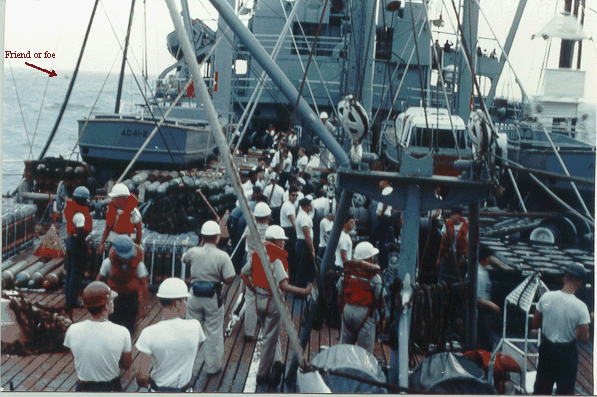
| Photo by Elpidio Casteneda |
Friend or foe?
One of the greatest fears of the officers and crew of the
Mattaponi during the Vietnam
War was the possibility of being mined or fired upon with a RPG (rocket
propelled grenade) from a fishing
boat or junk. Underway replenishments lasted for many hours in the Combat
Zone. Connected together by
fuel lines, telephone line, and/or high-line, necessitated traveling in a
straight line for long distances. This
made the Mattie an extremely big slow moving target, especially when near
empty, full of fumes, and
showing 20 feet of black paint. Being a near 30 year old converted
merchant and rusting as all old oilers
do, from the inside out, she had no armor and lots of loose rivets. She
creaked loudly, moaned and groaned
especially during typhoons.
In an area off the coast of South Vietnam near DMZ known as Market Time One, it was not uncommon for very brave Viet Cong or NVA fishing boat or junk sailors to try and breakup underway replenishments by floating between connected ships. Thus forcing an emergency breakaway and attempting to inflict casualties on the officers and crew of the Mattaponi. Wire rope (steel cables), manila lines (rope), or even a 30 foot boom jackknifing represent a serious threat to personal on deck during a breakaway. There were over 50,000 licensed boats (junks and fishing boats) under white sail off the coast of South Vietnam alone.
Tug of War at rest— 30 man hi-line
In Corpsman 2nd Class Castenada’s photo, Mattaponi shows her rather
unusual technique of passing
ammunition. Note: How clever cargo handler uses pallets of 5” high
explosive projectiles to coral bottled
gasses as ship rolls and pitches in moderate seas. Wood cargo deck was
rounded so personal could walk
on deck as the ship rolled. Also 30 man high-line is some what hidden
behind pallets of 5” black powder
canisters. Boatswains chair is being retrieved.
Mattaponi supported the hospital ships, Sanctuary and Repose, with fuel and bottled gasses during the Tet Offensives (Springs) of 1967, 1968, 1969 and 1970. The hospitals ships cared for wounded US Marines in the waters off I Corps (Market Time One) throughout the Vietnam War.
| Dennis Miller |